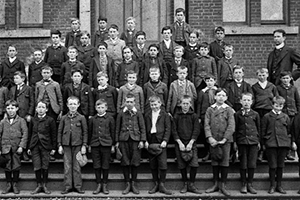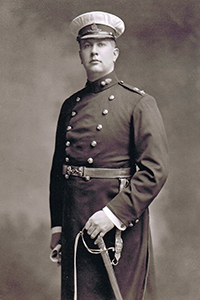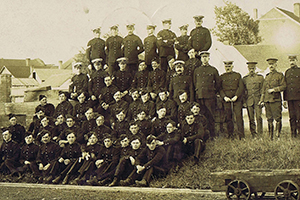
Vimy Ridge Memorial.
Credit: Doncoombez
General Sir Arthur Currie
Fort Rodd Hill and Fisgard Lighthouse National Historic Sites
At Fort Rodd Hill visitors will find a plaque commemorating General Sir Arthur Currie, who not only trained on the site in the early 20th century, but went on to be the most influential Canadian soldier of the First World War.
General Sir Arthur Currie, an Architect of Vimy Ridge: The man, the myth
The Battle of Vimy Ridge took place April 9 to 12, 1917 during the First World War. A hero of this battle was General Sir Arthur Currie, GCMB, KCB. This former school teacher, and a general who had never attended a military college but who had radical ideas about warfare, was the pre-eminent reason for Canadian success at the Battle of Vimy Ridge.
From school teacher to General
 Division III, Boys Central School, Victoria; teacher is Sir Arthur Currie; J.B. Clearihue and pupils – 1899
Division III, Boys Central School, Victoria; teacher is Sir Arthur Currie; J.B. Clearihue and pupils – 1899
Gunner Arthur William Currie began his military career in Victoria, British Columbia in 1897 with the 5th Regiment, Canadian Garrison Artillery as a Private. Currie was quickly promoted to bombardier (or corporal), then received a commission to lieutenant that same year. His quick rise through the ranks resulted from Currie’s ability to train his colleagues and get the desired results.
Over the period of 1907 to 1913, the 5th Regiment won every possible Dominion trophy for competitions in Canada and several international competitions. The 5th Regiment, with Currie leading, was recognized as “the best gunnery corps in the Dominion.”
In civilian life, Currie was a school teacher. The expression, “great teachers are born, not made” certainly applied to Currie. Whether it was school children or young gunners, Currie’s teaching talent was evident and strengthened his career, despite reluctance and even ridicule from his British contemporaries. The 5th Regiment, with Currie leading, was recognized as the best gunnery corps in the Dominion.
Rising ranks, communicating battle plans and amassing successes

Portrait of Lieutenant-Colonel Sir Arthur Currie, 1909
At the outbreak of the war in August 1914, Currie was the Commanding Officer of the newly formed 50th Gordon Highlanders in Victoria (this after leaving the 5th Regiment with the rank of Lieutenant-Colonel).
By September 29th, Currie had again been promoted, this time to Brigadier General, and was on his way to Europe in charge of one of Canada’s infantry brigades. After a series of great successes, including the Second Battle of Ypres, Currie was promoted to Major-General and was given command of the entire First Canadian Division.
Since men in leadership positions were often killed or wounded in battle, Currie supported ensuring all ranks were aware of the entire battle plan, something many of his British comrades thought foolish and dangerous.
Despite this criticism, commanding officers at all levels from General to Corporal received trench maps and training on mock battlefields located behind the frontlines. He also gave specific objectives down to platoon and section level. While high-ranking British officers doubted Currie’s methods, the general’s ability to instruct played a pivotal role in the upcoming battle set for early April.
Winning one of the most famous battles of the Great War
The battle for Vimy Ridge has become almost mythic in proportion here in Canada, but let’s look at the hard facts:
 Lieutenant-Colonel Sir Arthur Currie with regiment
Lieutenant-Colonel Sir Arthur Currie with regiment- Currie, as the commander of the First Canadian Division, was one of the key architects of the attack of April 9th, along with his superior, Lieutenant-General Sir Julian Byng, a British Officer who was in command of the entire Canadian Corps.
- Byng instructed Currie to study the successes and failures of previous battle plans, in particular Verdun, and bring those lessons to the plan for Vimy.
- Currie insisted that all men be aware of the battle plan so that it could still be executed even if commanding officers were killed in battle.
- Junior officers were asked for input and suggestions.
- The artillery played not just an important role in the initial stages of the battle, but the concept of the “rolling barrage” was employed to keep the enemy in the dugouts until Canadian forces were right on top of them.
- Technology played an important role: German guns were identified using echolocation and trigonometry so that many were destroyed in the initial stages of the battle.
- Smaller groups of soldiers were assigned objectives beyond just “taking the hill”. Soldiers knew their objectives and what to do if an officer or senior NCO was wounded or killed.
None of these strategies were particularly new; most had been tried before. What Currie did was employ them all together with a level of training befitting a school teacher. His expertise with artillery and willingness to allow others input into his plan made success a much surer thing.
By noon on April 9th, most of Vimy Ridge had been captured. Hill 145 (the highest point of the ridge) was taken on April 10th. Two days later another high point of the ridge known as “The Pimple” was taken. The four Canadian Divisions, which made up the majority of the troops, consisted of battalions from every province in the young dominion. A former school teacher… a general who had never attended a military college with radical ideas about warfare, had taken colonial troops and, with detailed planning and precision, helped plan and win one of the most famous battles of the Great War.
Two months after Vimy Ridge, Lieutenant-General Byng was promoted to command Britain’s Third Army, and Currie was promoted into Byng’s position, making him the first Canadian to be the commander of the Canadian Corps.
Canadian success in the last 18 months of the war was in large part due to Currie. In his new position as commander of the entire Canadian Corps, he was able to design and implement battle plans with greater freedom, and put his revolutionary tactics to use in battles like Hill 70 and Amiens which had substantial and lasting impact on the ultimate success of the Allies on the Western Front.
- Date modified :